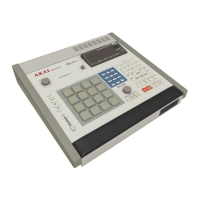4.3 The EDIT ke
The EDIT key encompasses the following functions related to
editing of the active sequence:
• Viewing all time signature changes
• Creating a new sequence
• Inserting blank bars into a sequence
• Deleting specified bars from a sequence
• Copying a section and inserting it elsewhere within the same or another
sequence
• Copying a single track to another area or merging it with other data
• Copying an entire sequence to another sequence
• Converting a song to one long sequence
• Lengthening or shortening a bar by changing the time signature
• Changing the velocity or duration values of a group of notes after
recording
When the EDIT key is pressed, the following screen is displayed:
Pressing a single number key will cause the screen for the selected function
to be dis
la
ed.
4.3.1 Viewing time signature changes
This function displays the time signature and number of bars in the active
sequence, and any time signature changes, but does not allow any changes to
be made. To use this function, select option 1 from the EDIT screen and the
following screen will be displayed:
88

